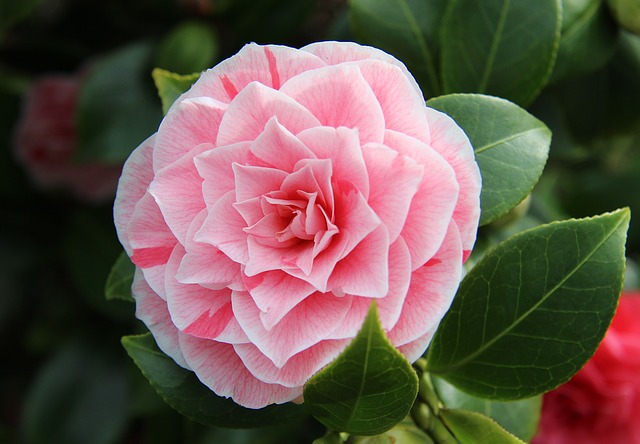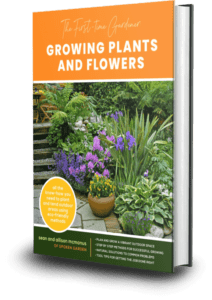Perfect for your winter-blooming garden, learn all about the beautiful, easy-to-grow Camellia plant in this gardener’s guide.

You are looking for a way to liven up your winter garden.
It is boring, lacking color, and needs a boost. What about planting a Camellia plant?
Many varieties of Camellia have been bred to bloom in the winter, their leaves are used for tea, and they will look beautiful in your garden.
If you already have a Camellia, you’re in the right place because we’ll teach you how to properly care for it!
Quick and Dirty: Fast Plant Care Facts (main profile further below)
| Sun Exposure | Most prefer partial to full shade, but some older plants can take full sunlight with their roots completely shaded from the sun. Protect all plants from hot, strong sun and drying winds. |
| Water Needs | Moderate to regular watering. |
| Soil Needs | Well drained, high in organic matter. Mulch 2-inches thick to keep roots cool and moist. |
| Cold-Hardiness Zones | USDA hardiness zones 7 to 10, with some hardy down to zone 6. |
| Bloom Time | Winter into Spring, depending on species and cultivar. |
| Flower Colors | Rose, White, Pink, Burgundy, Orange, Cream, mixed colors, Purple, Yellow, and many different hues and shades of all these colors. |
| Mature Height/Width | Range from 3ft up to 20+ ft |
| Plant Spacing | Depends on species and cultivar needs. |
Become a Plant Profile Club member here, if you want more camellia plant care information than this!
[convertkit form=1655951]
Read our Camellia plant post below to learn:
- Camellia plants for sale
- A brief history and popular uses of Camellia, like for tea
- Fun facts, and so much more!
In a hurry? Pin it for later!!
Camellias: Why We’re Featuring This Plant
First, Camellias are known as a winter bloomer, but they can bloom anywhere from fall through spring season depending on the climate and variety of plant.
The Camellia is a widely used and indispensable foundation plant in landscapes around the world for mostly shaded areas and for winter flower interest.
In addition, they are a well-rounded, well-traveled plant. With their possible cultivation dating back 5,000 years, this plant has an interesting history and today has “blossomed” into a highly regarded plant around the world.
Plus, they can live hundreds of years if properly cared for!
Finally, we’re featuring the Camellia because of their economic significance. Native to the eastern and southern parts of Asia, Camellias have been selectively bred for years to produce the perfect tea leaves, and who doesn’t love a good cup of tea?
You can find more of camellia care needs, when it flowers, its uses, and more by becoming a Plant Profile Club member.
Camellia Flower: History and Uses
Camellia Family
Camellias are in the Theaceae family. Also known as the “Tea Family,” this family includes flowering plants, shrubs, and trees.
Originally from parts of Asia, there are over 200 different species of Camellia today with a total number of varieties believed to be as high as 20,000. Wow.
Other genera in the family include Franklinia, Stewartia, and Cleyara, to name a few.
Camellia History
Camellia has an interesting history tracing back thousands of years.
Named by Carl Linneaus after the Jesuit botanist priest, Joseph Kamel, Camellias serve a valuable role in the economic market as the “tea plant.”
Research indicates that the Ancient Chinese first started cultivating Camellias around 2700 BC.
Around 1700 B.C., tea, produced from the C. sinensis variety, first became popular in China during the reign of Emperor Nung.
Eventually, during the period of trade between the late 1600-mid 1700s, the East India Company brought tea from China to Europe where it became very popular and highly sought after.
By the early 1900s, the plant made its way to America and other parts of the world and the rest is history.
Today, most Camellias are grown and used for ornamental purposes but many varieties are used in cooking, cosmetics, hair care, as tea oil, and in Chinese herbal medicine.
If you want to read more about the history of Camellias, check out American Camellia Society.
Where do Camellias Grow Best?
Camellias grow their best in mostly shaded locations with well draining soil that is slightly acidic with regular watering, either by rain or by you.
They like to have their roots not directly exposed to the sun or heat, and to be protected from high winds, as these plants can get top heavy over time and can be blown over rather easily if not properly maintained and tended to.
They do their best in soils high in organic matter and really like at least 2-inches of mulch covering their immediate roots to keep those roots cool and insulated.
Camellia Tea
Did you know that one specific species of Camellia is the main source for your tea?
The species Camellia sinensis, specifically the varieties sinensis and assamica are the main source for Camellia leaf tea around the world.
These two Camellia varieties are responsible for:
-
- Black Tea,
- Yellow Tea,
- White Tea,
- Green Tea,
- Oolong Tea, and
- Dark Tea
To make each one of these teas, the leaves are processed differently to get that specific flavor or, as the tea experts say, oxidation.
Many generations of selective breeding have occurred to make the perfect tea leaves.
Camellia Care
You can find more of camellia care needs, when it flowers, its uses, and more by becoming a Plant Profile Club member.
Camellia Plants For Sale
Want to buy your own Camellia plants after learning all about their characteristics?
Check these out!
Or, do you need to shop for other garden plants for this spring?
Click here for the most up to date deals and plants on Amazon!
Camellia Plant Conclusion
Today, Camellias are highly valued and economically significant for their leaves.
A wonderful addition to any garden, Camellia plants have been specially bred to bloom anywhere from winter through fall season depending on the variety.
Imagine planting several varieties of Camellia in your yard and you could have color year-round!
With just a bit of regular maintenance necessary, their bright colors and lengthy history, Camellias are a perfect winter bloomer and complement to any garden season after season.
Well, that’s all for now.
Thanks for reading and we hope we inspired you or educated you in some way with our Camellia plant profile.
Want to learn about other plants in your garden? Check out some of our other plant profiles:
- The Gardener’s Guide to Dianthus
- The Gardener’s Guide to Chrysanthemums
- Hello Hellebore! January Plant Profile
- A Rose By Any Other Name: February Plant Profile
- Daffodil: A Gardener’s Guide and Plant Profile
See you in the garden!
~ Sean and Allison
P.S. Find us on Pinterest, Twitter, Facebook, and Instagram so you don’t miss a thing!
Camellia References Used:
Spokengarden.com is a participant in the Amazon Services LLC Associates Program, an affiliate advertising program designed to provide a means for sites to earn advertising fees by advertising and linking to Amazon.com
Perfect for your winter-blooming garden, learn all about the beautiful, easy-to-grow Camellia plant in this gardener’s guide.










